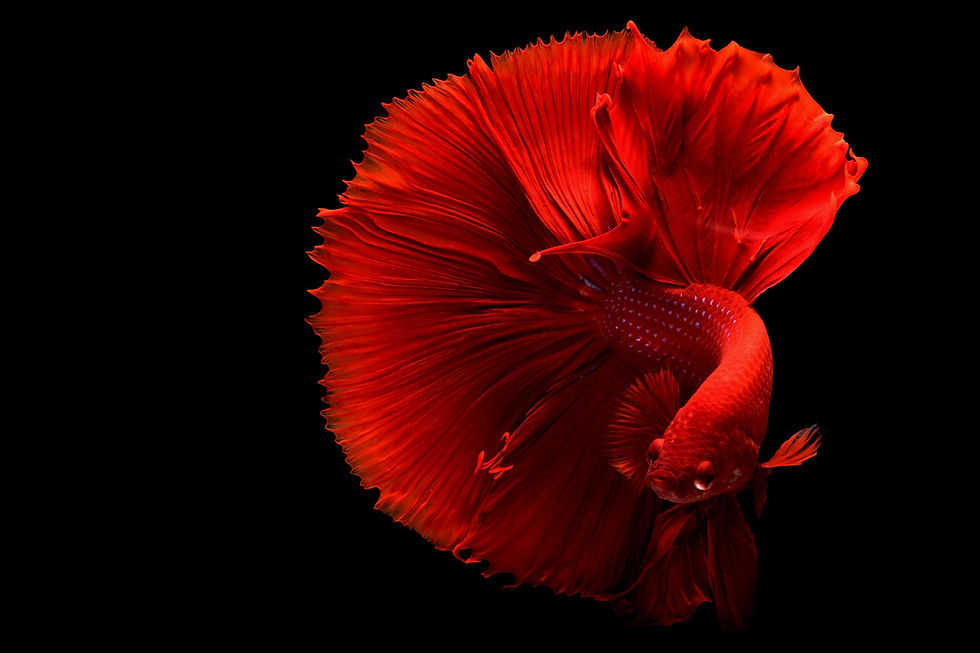Tips For Keeping Your Halfmoon Betta Happy and Healthy
- bettaworldforbettas

- Sep 12
- 5 min read

By Conner Tighe
They may be small, but halfmoon bettas have a way of stealing the spotlight. With tails that fan
out a full 180 degrees like a living work of art, these fish are often the jewel of a home aquarium.
But while their dramatic fins and vivid colors make them irresistible to aquarists, they also come
with unique care needs that can’t be ignored.
Keeping a halfmoon betta happy and healthy takes more than just placing it in a bowl of water.
From tank setup to diet to daily care, every choice you make affects the well-being of this
delicate but captivating species. Whether you’re a first-time betta owner or a seasoned
fishkeeper looking to refine your routine, these tips will help ensure your halfmoon betta doesn’t
just survive — it thrives.
Choose the Right Tank Setup
One of the most common mistakes new betta owners make is underestimating how much space
these fish actually need. While it’s true you’ll often see bettas sold in tiny cups or advertised for
small bowls, halfmoon bettas require more room to truly flourish. Experts recommend a tank of
at least five gallons, which provides the swimming space they need and facilitates maintaining
stable water conditions.
A secure lid is also essential. Bettas are notorious jumpers, and a curious halfmoon can easily
end up outside the tank if it’s left uncovered. Inside the tank, think comfort: live or silk plants
provide both enrichment and hiding spots, while smooth decorations allow your betta to explore
without the risk of tearing its delicate fins.
The goal is to create a space that’s both functional and stimulating — a safe environment where
your halfmoon can show off its natural beauty without stress.
Maintain Ideal Water Conditions
If there’s one secret to keeping a halfmoon betta healthy, it’s consistency. These fish thrive in
warm, clean water, and even minor changes in their environment can have a significant impact.
Aim for a temperature between 76 and 82 degrees Fahrenheit, using a reliable heater to keep
things steady. Bettas are tropical fish, and cooler water will leave them sluggish and more
vulnerable to disease.
Water quality matters just as much. A gentle filter helps keep the tank clean, but it’s crucial to
avoid strong currents that could push your betta around and damage its flowing tail. Weekly
partial water changes are essential for removing waste and maintaining optimal levels of
ammonia, nitrite, and nitrate.
Keeping an eye on pH is also worthwhile — halfmoon bettas do best in slightly acidic to neutral
water, ideally between 6.5 and 7.5. Investing in a simple test kit can make all the difference in
spotting problems early, before they affect your fish’s health.
Provide a Balanced Diet
A healthy halfmoon betta is a vibrant halfmoon betta, and diet plays a major role in maintaining
their fins' color and high energy levels. The best place to start is with high-quality betta pellets,
formulated specifically to meet their nutritional needs. These should form the foundation of their
diet.
To add variety — and a little excitement — you can supplement with frozen or live foods such as
brine shrimp, daphnia, or bloodworms. These protein-rich treats mimic what bettas might eat in
the wild and help bring out their natural colors. Just be sure to feed them in moderation, as too
much rich food can lead to bloating or digestive issues.
Overfeeding is one of the most common mistakes betta owners make. A good rule of thumb is
to offer only as much food as your fish can eat in two minutes, once or twice a day. A small,
measured diet keeps your halfmoon betta lean, healthy, and ready to show off those flowing
fins.
Prevent Fin Damage
The halfmoon’s sweeping tail is what makes it so striking — and what makes it so vulnerable.
Those delicate fins can tear easily, and once damaged, they’re more susceptible to infection.
Prevention starts with the right tank decor. Avoid sharp plastic plants or rough ornaments that
could snag the fins; opt for live plants or soft silk alternatives instead.
Filtration is another factor. A strong current might seem like a sign of good circulation, but for a
halfmoon, it can be exhausting and even harmful. Gentle filtration keeps the water clean without
forcing your betta to fight against the flow, reducing the risk of torn or frayed fins.
Regular observation is just as important. Make a habit of checking your betta’s tail for early
signs of trouble, such as ragged edges or blackened tips. Catching issues early means you can
treat problems like fin rot before they spread, helping your fish recover more quickly.
Minimize Stress
Halfmoon bettas may look bold with their broad, dramatic tails, but they’re actually sensitive fish
that can easily be stressed by their surroundings. Too much stress weakens their immune
system, leaving them more prone to illness. The good news is that a few simple adjustments
can make their world much calmer.
Start with location: place the tank somewhere quiet, away from constant foot traffic, loud
televisions, or slamming doors. These sudden movements and noises can make your betta feel
threatened. Inside the tank, providing plenty of plants and hiding spaces gives your fish a safe
retreat when it wants to be alone.
It’s also worth avoiding rapid environmental changes. Sudden shifts in water temperature,
lighting, or even your routine can unsettle your betta. While mirrors can be used sparingly to
provide stimulation and exercise, too much reflection can make a halfmoon feel like it’s under
constant attack. The goal is balance — enough enrichment to keep your fish active without
overwhelming them.
Choose Tankmates Carefully (or Not at All)
When it comes to companionship, halfmoon bettas are often happiest on their own. Their long
fins make them slow swimmers and easy targets, while their natural territorial instincts can lead to conflict with the wrong neighbors. For many aquarists, a single betta in a well-decorated tank is the safest and most stress-free option.
That said, it is possible to keep halfmoons with carefully chosen tankmates. Peaceful species
that won’t nip at fins — such as small schooling fish, shrimp, or snails — can sometimes coexist
successfully. The key is to avoid aggressive or flashy fish, particularly those with long fins, which
bettas may mistake for rivals.
Even with the right companions, close observation is essential. If your halfmoon shows signs of
stress or aggression, such as flaring, chasing, or hiding excessively, it’s best to separate the fish
before injuries occur. In the end, your betta’s well-being should come first, whether that means
sharing space or enjoying a tank all to itself.
Monitor Health Regularly
Even in the best conditions, halfmoon bettas can face health challenges. Their long fins make
them especially vulnerable to issues like fin rot, while stress or poor water quality can lead to
problems such as ich, bloating, or lethargy. Staying attentive to small changes in behavior or
appearance is one of the best ways to catch problems early.
Look for warning signs such as clamped fins, loss of appetite, or unusual swimming patterns. A
betta that spends most of its time hiding or lying at the bottom of the tank may be signaling that
something is wrong. Regular health checks — even just a few minutes of observation each day
— can help you spot these red flags before they become serious.
Having a treatment plan is equally essential. A simple quarantine setup allows you to isolate a
sick fish when needed, reducing the risk of spreading illness. Quick action, combined with
proper care, can make the difference between a minor setback and a lasting problem.
This article was written by Conner Tighe.




Comments